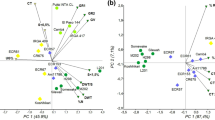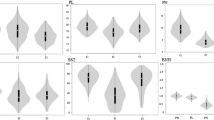Abstract
The present study was conducted to understand the pattern of variation and the genetic bases for cold tolerance at the early growth stage in Asian rice. The genetic variation was investigated at the germination, plumule and seedling stages among 57 strains including cultivated rice (Oryza sativa ssp. indica and ssp. japonica) and its wild progenitor (Oryza rufipogon). The significant differentiation of cold tolerance was observed among the taxonomically divided groups. At the germination stage, both indica and japonica subspecies tended to be more tolerant than O. rufipogon, whereas at the plumule and seedling stages, ssp. japonica tended to be more tolerant than ssp. indica and O. rufipogon. Furthermore, in cold tolerance at the plumule stage, the clinal variation across the latitude of origins was observed within O. rufipogon and ssp. japonica, suggesting that the current pattern of variation seems to have been shaped by both their phylogenetic histories and on-going adaptation to the local environments. QTL analysis between O. sativa ssp. japonica (tolerant) and O. rufipogon (susceptible) revealed five putative QTLs for cold tolerance at the plumule and seedling stages but not at the germination stage. Substitution mapping was also carried out to precisely locate the two major QTLs for cold tolerance at the plumule stage, which could be used for improvement of tolerance to cold stress in ssp. indica.




Similar content being viewed by others
Explore related subjects
Discover the latest articles and news from researchers in related subjects, suggested using machine learning.References
Andaya VC, Mackill DJ (2003) Mapping of QTLs associated with cold tolerance during the vegetative stage in rice. J Exp Bot 54:2579–2585. doi:10.1093/jxb/erg243
Andaya VC, Tai TH (2006) Fine mapping of the qCTS12 locus, a major QTL for seedling cold tolerance in rice. Theor Appl Genet 113:467–475. doi:10.1007/s00122-006-0311-5
Cai HW, Morishima H (2002) QTL clusters reflect character associations in wild and cultivated rice. Theor Appl Genet 104:1217–1228. doi:10.1007/s00122-001-0819-7
Chuong PV, Omura T (1982) Studies on the chlorosis expressed under low temperature in rice, Oryza sativa L. In: Bulletin of the Institute of Tropical Agriculture, vol 5. Kyushu University, Fukuoka, Japan, pp 1–58
Fujino K, Sekiguchi H, Sato T, Kiuchi H, Nonoue Y, Takeuchi Y et al (2004) Mapping of quantitative loci controlling low-temperature germinability in rice (Oryza sativa). Theor Appl Genet 108:794–799. doi:10.1007/s00122-003-1509-4
Garris AJ, Tai TH, Coburn J, Kresovich S, McCouch S (2005) Genetic structure and diversity in Oryza sativa L. Genetics 169:1631–1638. doi:10.1534/genetics.104.035642
Glaszmann JC (1987) Isozymes and classification of Asian rice varieties. Theor Appl Genet 74:21–30. doi:10.1007/BF00290078
Glaszmann JC, Kaw RN, Khush GS (1990) Genetic divergence among cold tolerant rices (Oryza sativa L.). Euphytica 45:95–104
Gong Z, Lee H, Xiong L, Jagendorf A, Stevenson B, Zhu JK (2002) RNA helicase-like protein as an early regulator of transcription factors for plant chilling and freezing tolerance. Proc Natl Acad Sci USA 99:11507–11512. doi:10.1073/pnas.172399299
Ikehashi H (1973) Studies on the environmental and varietal differences of germination habits in rice seeds with special reference to plant breeding. J Cent Agric Exp Stan 19:1–60 (in Japanese with English summary)
Kwak TS, Vergara BS, Nanda JS, Coffman WR (1984) Inheritance of seedling cold tolerance in rice. SABRAO J 16:83–86
Lander ES, Botstein D (1989) Mapping Mendelian factors underlying quantitative traits using RFLP linkage maps. Genetics 121:185–199
Lee HS, Taguchi K (1969) Studies on the germinability of rice seeds at low temperature. I. The varietal differences and effects of growing conditions of parent plants on the germinability of rice seeds at low temperature. Mem Fac Agric Hokkaido University 7:138–146 (in Japanese with English summary)
Lou Q, Chen L, Sun Z, Xing Y, Li J, Xu X et al (2007) A major QTL associated with cold tolerance at seedling stage in rice (Oryza sativa L.). Euphytica 158:87–94. doi:10.1007/s10681-007-9431-5
Ma J, Bennetzen JL (2004) Rapid recent growth and divergence of rice nuclear genomes. Proc Natl Acad Sci USA 101:12404–12410. doi:10.1073/pnas.0403715101
Mackill DJ, Lei X (1997) Genetic variation for traits related to temperate adaptation of rice cultivars. Crop Sci 37:1340–1346
Misawa S, Mori N, Takumi S, Yoshida S, Nakamura C (2000) Mapping of QTLs for low temperature response in seedlings of rice(Oryza sativa L.). Cereal Res Commun 28:33–40
Mitchell-Olds T, Willis JH, Goldstein DB (2007) Which evolutionary processes influence natural genetic variation for phenotypic traits? Nat Rev Genet 8:845–856. doi:10.1038/nrg2207
Miura K, Lin SY, Yano M, Nagamine T (2001) Mapping quantitative trait loci controlling low-temperature germinability in rice (Oryza sativa L.). Breed Sci 51:293–299. doi:10.1270/jsbbs.51.293
Monna L, Lin HX, Kojima S, Sasaki T, Yano M (2002) Genetic dissection of a genomic region for a quantitative trait locus, Hd3, into two loci, Hd3a and Hd3b, controlling heading date in rice. Theor Appl Genet 104:772–778. doi:10.1007/s00122-001-0813-0
Morishima H, Oka HI (1981) Phylogenetic differentiation of cultivated rice, XXII. Numerical evaluation of the indica-japonica differentiation. Jpn J Breed 31:402–413
Murray MG, Thomson WF (1980) Rapid isolation of high molecular weight plant DNA. Nucleic Acids Res 8:4321–4325. doi:10.1093/nar/8.19.4321
Nagamine T (1991) Genic control of tolerance to chilling injury at seedling stage in rice. Jpn J Breed 41:35–40
Nagamine T, Nakagahra M (1990) Genetic variation of chilling injury at seedling stage in rice, Oryza sativa L. Jpn J Breed 40:449–455
Oka HI (1954) Phylogenetic differentiation of the cultivated rice plant. V. Variation of minimum germination temperature and temperature constant among rice varieties. Jpn J Breed 4:6–10 (in Japanese)
Oka HI (1958) Intervarietal variation and classification of cultivated rice. Indian J Genet Plant Breed 18:79–89
Oka HI (1988) Origin of cultivated rice. Elsevier, Tokyo
Oka HI, Chang WT (1960) Survey of variations in photoperiodic response in wild Oryza species. Bot Bull Acad Sinica (Taiwan) 1:1–14
Onishi K, Horiuchi Y, Ishigoh-Oka N, Takagi K, Ichikawa N, Maruoka M et al (2007) A QTL cluster for plant architecture and its ecological significance in Asian wild rice. Breed Sci 57:7–16. doi:10.1270/jsbbs.57.7
Rozen S, Skaletsky HJ (2000) Primer3 on the WWW for general users and for biologist programmers. In: Krawetz S, Misener S (eds) Bioinformatics methods and protocols: methods in molecular biology. Humana Press, Totowa
Satake T (1976) Sterility-type cool injury in paddy rice plants. In: Institute International Rice Research (ed) Climate and rice. International Rice Research Institute, Los Baños, Philippiness
Schaal BA, Gaskin JF, Caicedo AL (2003) Phylogeography, hpaplotype trees, and invasive plant species. J Hered 94:197–204. doi:10.1093/jhered/esg060
Skøt L, Sackville Hamilton NR, Mizen S, Chorlton KH, Thomas ID (2002) Molecular genecology of temperature response in Lolium perenne: 2. Association of AFLP markers with ecogeography. Mol Ecol 11:1865–1876. doi:10.1046/j.1365-294X.2002.01568.x
Temnykh S, DeClerck G, Lukashova A, Lipovich L, Cartinhour S, McCouch S (2001) Computational and experimental analysis of microsatellites in rice (Oryza sativa L.): frequency, length variation, transposon associations, and genetic marker potential. Genome Res 11:1441–1452. doi:10.1101/gr.184001
Thomashow MF (1999) Plant cold acclimation: freezing tolerance genes and regulatory mechanisms. Annu Rev Plant Physiol Plant Mol Biol 50:571–599. doi:10.1146/annurev.arplant.50.1.571
Van Ooijen JW, Boer MP, Jansen C, Maliepaard C (2002) Map QTL 4.0: software for the calculation of QTL position on genetic maps. Plant research international, Wageningen (Netherlands)
Vaughan DA, Morishima H, Kadowaki K (2003) Diversity in the Oryza genus. Curr Opin Plant Biol 6:139–146. doi:10.1016/S1369-5266(03)00009-8
Vergara BS (1976) Physiological and morphological adaptability of rice varieties to climate. In: Institute International Rice Research (ed) Climate and rice. International Rice Research Institute, Los Baños, Philippines
Vitte C, Ishii T, Lamy F, Brar D, Panaud O (2004) Genomic paleontology provides evidence for two distinct origins of Asian rice (Oryza sativa L.). Mol Genet Genomics 272:504–511. doi:10.1007/s00438-004-1069-6
Zhang ZH, Su L, Li W, Chen W, Zhu YG (2004) A major QTL conferring cold tolerance at the early seedling stage using recombinant inbred lines of rice (Oryza sativa L.). Plant Sci 168:527–534. doi:10.1016/j.plantsci.2004.09.021
Zhen T, Ungerer MC (2008) Clinal variation in freezing tolerance among natural accessions of Arabidopsis thaliana. New Phytol 177:419–427
Zhu Q, Ge S (2005) Phylogenetic relationship among A-genome species of the genus Oryza revealed by intron sequences of four nuclear genes. New Phytol 167:249–265. doi:10.1111/j.1469-8137.2005.01406.x
Acknowledgements
This work was supported in part by grants from the Ministry of Education, Culture, Sports, Science and Technology of Japan.
Author information
Authors and Affiliations
Corresponding author
Rights and permissions
About this article
Cite this article
Baruah, A.R., Ishigo-Oka, N., Adachi, M. et al. Cold tolerance at the early growth stage in wild and cultivated rice. Euphytica 165, 459–470 (2009). https://doi.org/10.1007/s10681-008-9753-y
Received:
Accepted:
Published:
Issue Date:
DOI: https://doi.org/10.1007/s10681-008-9753-y




